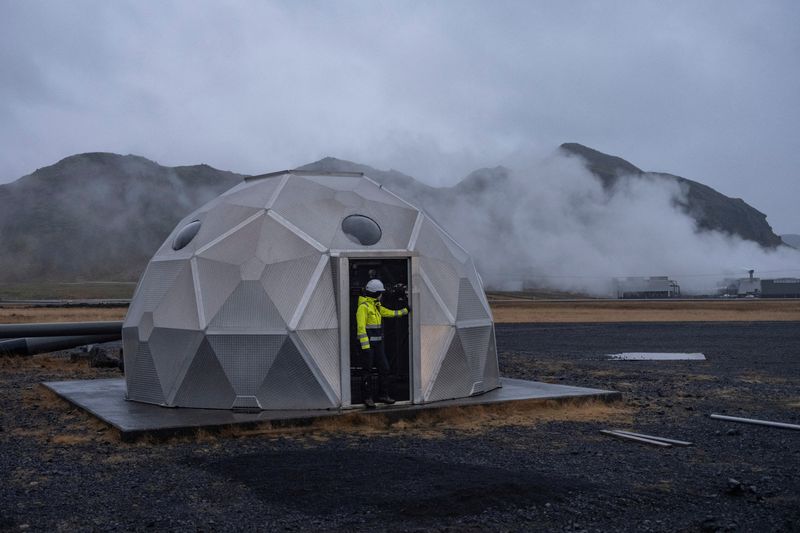By Timothy Gardner
(Reuters) – Governments and investors are pouring billions of dollars into emerging technologies to combat global warming in long-shot bets that entrepreneurship can help lead the way to a climate-friendly world.
As officials from nearly 200 countries seek to forge agreements at the U.N. COP28 climate summit in Dubai this month, they will also be considering deployment of the nascent technologies.
The amount invested worldwide by venture capital and private equity into climate technology startups – in projects ranging from carbon capture and green hydrogen, to food waste reduction and cleaning up heavy industry – totaled $490 billion this year, according to a report by accounting firm PwC.
While that’s down 40% from 2022 as economic uncertainty, stubborn inflation and high interest rates bite, it marks a relatively healthy showing given the investments across all business sectors dropped 50% over the same period, PwC said.
Here are some of the investment trends:
CARBON REMOVAL
The world emits around 37 billion metric tons of planet-warming carbon dioxide from fossil fuel and industry each year. One family of technologies, called carbon capture and storage, would tackle that by trapping those emissions before they reach the atmosphere, and storing them underground or using them to make products.
A big question, though, is whether it can work given the costs and the amount of energy required. The International Energy Agency, the West’s energy watchdog, said in November that the oil and gas industry is relying excessively on carbon capture, and called the approach an implausible “illusion”.
Even so, carbon removal is attracting loads of money.
The United States this year, for example, announced it would grant more than $1 billion to two carbon removal projects, in Texas and Louisiana, that would suck more than 2 million metric tons of carbon emissions per year from the sky using a carbon removal technique called direct air capture.
FUSION
Fusion, can generate massive amounts of zero-emissions power by harnessing the energy produced from pushing atoms together, instead of splitting them apart. But the reaction is hard to produce, and harness any energy it generates to the grid.
Investments in fusion slipped this year, part of the broader trend in declining venture investment. International fusion companies raised about $1.4 billion in mostly private money according to the Fusion Industry Association, down from about $2.83 billion in new investment last year.
On the hopeful side for fusion, the number of companies getting investments rose to 43 from 33, spanning a dozen countries, according to the FIA, including the U.S. which has about 25 companies. Other countries pursuing fusion include Australia, China, Germany, Japan, and the UK.
John Kerry, President Joe Biden’s climate envoy, is expected to announce at COP28 a global strategy in nuclear fusion.
GREEN HYDROGEN
Hydrogen is a fuel that can be made by electrolyzing water, and which burns clean. If it is produced using renewables like wind or solar power, as opposed to fossil fuel generated power, it is called green hydrogen. If it is produced with nuclear power, its called “pink” or “purple” hydrogen.
The U.S. is trying to kickstart clean hydrogen, and in October announced $7 billion in grants to seven “hydrogen hub” projects across the country. The U.S. Inflation Reduction Act also provides tax credits for hydrogen production.
Governments and companies think green hydrogen could be a way to clean up hard-to-decarbonize industries like steel and cement-making and other industrial manufacturing. But like carbon removal, it is expensive and energy intense, meaning it is unclear if it is doable at scale.
PwC said technologies like green hydrogen and reducing food waste have relatively high emissions reduction potential, but are receiving a small share of start-up investment. In 2023, green hydrogen got 3.9% of global climate-tech venture funding, while food waste got 0.7%, it said.
OTHERS
There are scores of other technologies in development that promise to be game-changers for the climate – if they survive. They include everything from lab-grown meat, to advanced batteries, to insects as a food source.
Among them, lab-grown meat has made some advancements this year. In June, U.S. regulators cleared the first sales of chicken grown from cells in a vat. The meat was served in small portions at high-end restaurants.
The industry says that if it manages to overcome high costs, challenges to scaling up production, and the ‘ick-factor’, it could revolutionize agriculture and eliminate the considerable emissions related to raising livestock.
ASIA, AFRICA ON THE RISE
Companies in the U.S. still get the most climate tech investment at around 49% of the global total, according to Deloitte, a professional services network.
But other countries have been eating into that share. Funding in China, for example, was 22% from 2020 to 2023, up from 2% in 2010 to 2014, while it has also increased in France, the UK and India and in other countries in Asia and Africa.
David Schatsky, a managing director at Deloitte, said investments in biofuels development has risen in Asia, while electric bike and motorcycle companies are doing well in Africa.
“Entrepreneurship taking hold outside of the developed world has the potential to help attract more capital to these regions if an ecosystem around climate-related technologies can arise,” Schatsky said.
___
For daily comprehensive coverage on COP28 in your inbox, sign up for the Reuters Sustainable Switch newsletter here.
(Reporting by Timothy Gardner; editing by Richard Valdmanis and Diane Craft)
